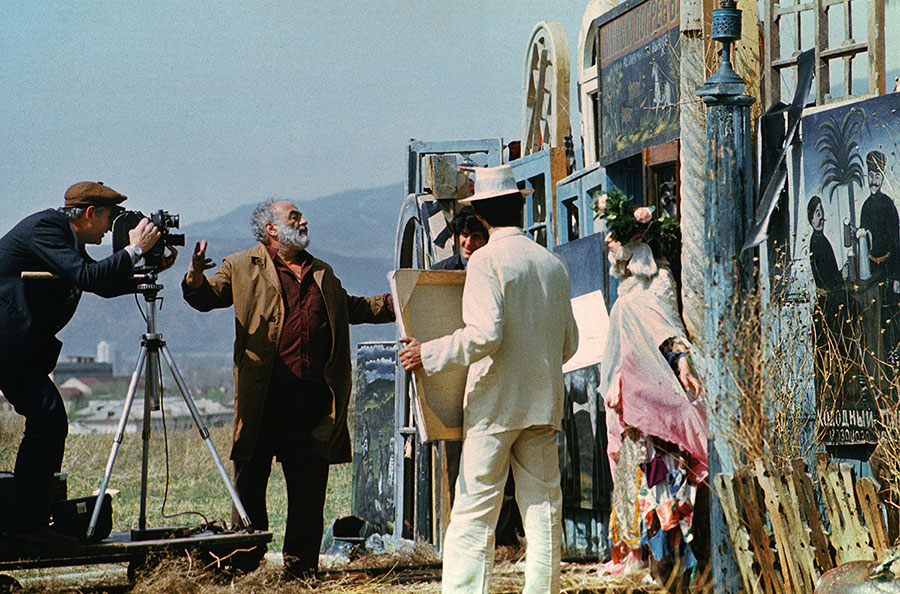Text and photo by Yuri Mechitov
Where one can trace the sources of creativity? Of course, in childhood. It seems Parajanov’s delivery to the world was without any specific problems. He used to play with his older sisters in their small yard decorated with a small pool in the center. They played very popular child game which in Russian sounds like Dom-Dom and means simply House-House. So Homo Ludens – Playing Man – started there. They repeated all that elders usually do – meeting guests, preparing meals, gossiping… This small children theatre was surrounded by the big one – theatre of real life, which included numerous neighbors of different ethnic origins and backgrounds. We in Tbilisi still name such yards surrounded by small houses as an Italian yards though they are exactly Tbilisi yards. It is an open place without completely isolated flats where inhabitants know nothing about their neighbors. Quite contrary – Italian yard people had a very vague understanding of privacy. They share everything what happened to them – joy and sorrow, happiness and grief, everything the life consists of. Tbilisi in general was known as a festive city with carefree easy-going population. In times of Russian Empire Tiflis became a southern stronghold of empire in Transcaucasia. It was multi ethnical, multi confessional city with its own way of life and multifaceted culture. In Soviet times Tbilisi and the whole Georgia regarded as a place where one could live and more freely than in other places. Unfortunately today times have changed not for better. I said in one of the last film dedicated to Parajanov, that today’s Tbilisi of concrete, steel and glass without cozy, full of performances yards can’t create conditions for such tremendous persons to come.
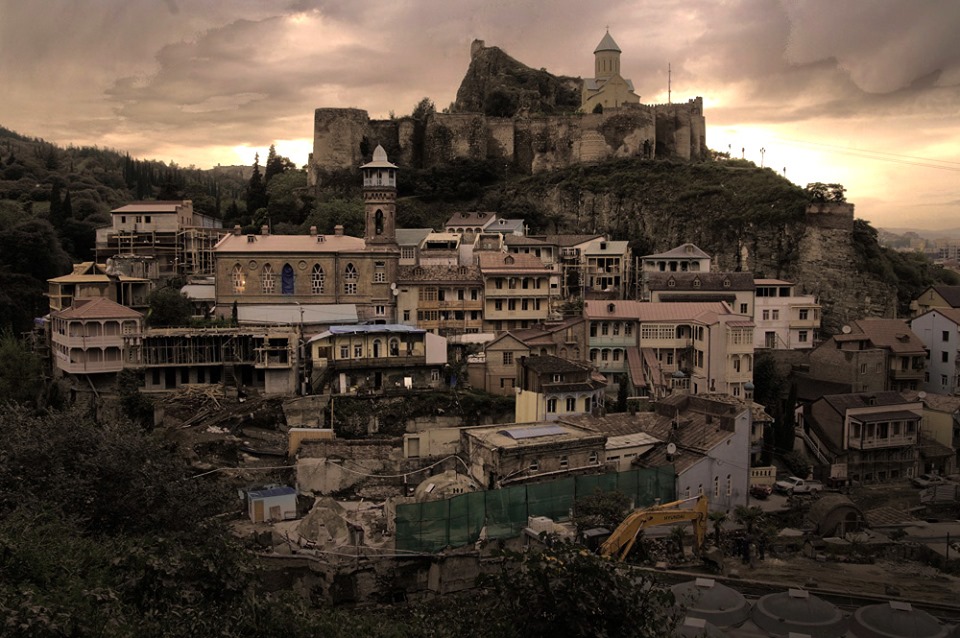
Parajanov was grown in a traditional Tbilisi Armenian family with its unbreakable laws and canons. But I can suggest that he it seems happily escaped any of the severe restrictions which make all of us so stupid in future. May be, because he was youngest among Iosif and Siranush children. So I suppose he was grown with the wings ready to fly. It’s also obvious that both his parents possessed a great vital energy which was inherited by young Sergei. His father Iosif was an extraordinary person – he ran antique shop, even brothel, was even arrested. It thanks to him Parajanov from early childhood learnt the beauty of things.
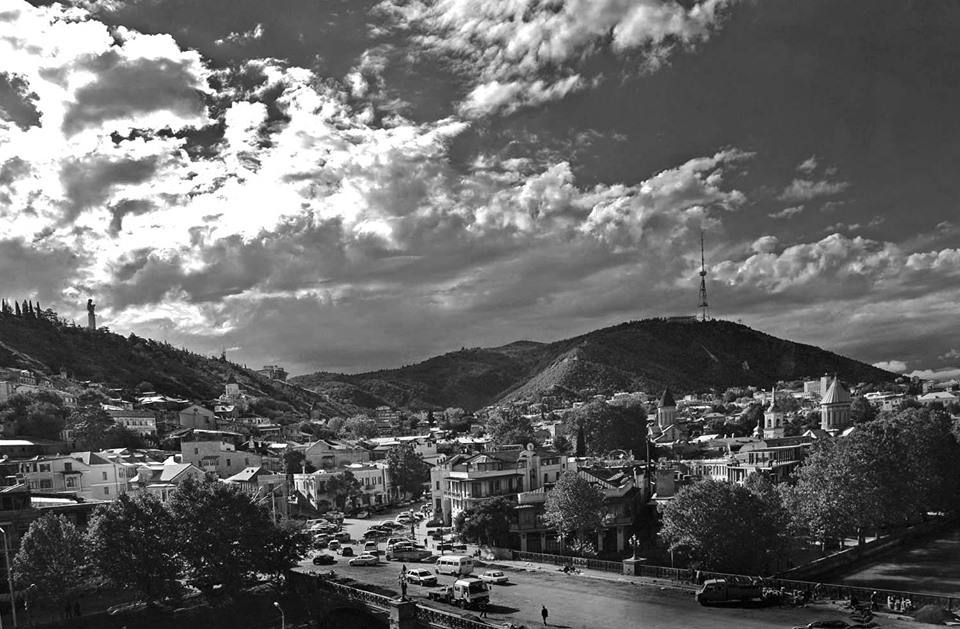
Whom can we name an artist, a creator? One who can see the world brighter and deeper than others, who is full with his own valuable (at least for him) opinion about the world and whose strong desire is to share those values, his understanding with others. So artist constantly seeks for ways how to deliver, how to render, how to transfer his unique vision almost to everybody. So I can determine the art as a message which can exists in different forms – poetry, music, painting, sculpture, photography, cinematography. I can add that for me the real artist is a person who creates with a very naïve and childish thought that with his creations he can change the world for better. It doesn’t mean that artist always has a clear understanding on that topic, but this sometimes unconscious drive is a basement. I have to add with sorrow that now we live in the very cynical world where there are not so many real artists. Majority of them are not directed with such naïve ideas and ideals. They don’t want to change the world – they are simply businessmen and art is their business.
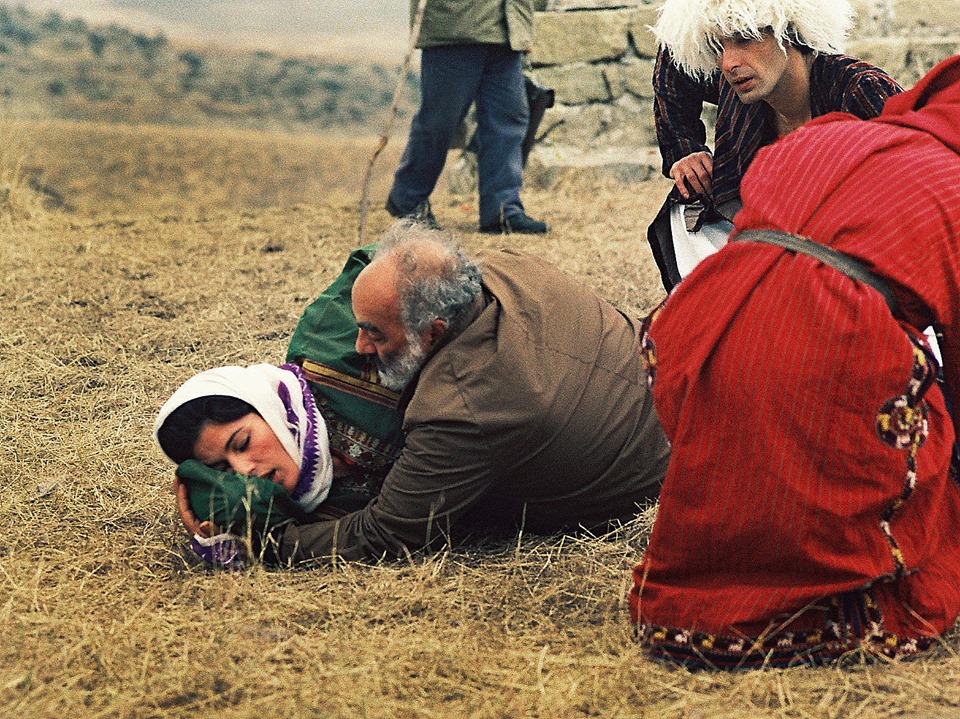
I remember very well how offended was Parajanov if somebody couldn’t understand his art, his message. He was so disappointed, he was so angry particularly on me, for my disability to see his creation the way he saw it. I remember he asked me to read his script Demon and he wanted immediately my response. But this script, its language, saturated with symbols, appeared very difficult to me to perceive at the first glance. So I started to explain something to Parajanov but it was impossible to fool him. Actually I failed to understand the very essence of his complicated for me work.
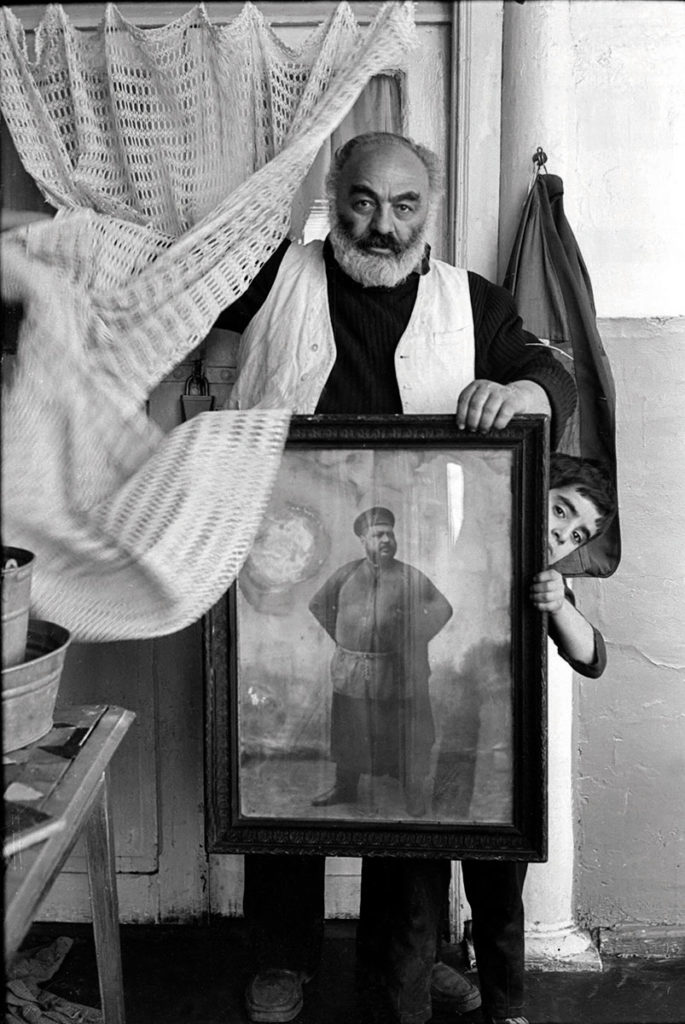
Every human being believes that God created him as an original, so he is unique. So every human being without exclusions strives, fights to confirm his own person and others around that he came to this beautiful and tragic at the same time world not by a chance. So he always needs a kind of confirmation – he wants to be distinguished, to be mentioned, to be famous, to be loved at last. It is a drive of all persons, but in case of a very gifted and energetic person this desire becomes a kind of obsession. I think without this ambitious obsession there’s no an artist. So for humble and no ambitious people art door is closed.
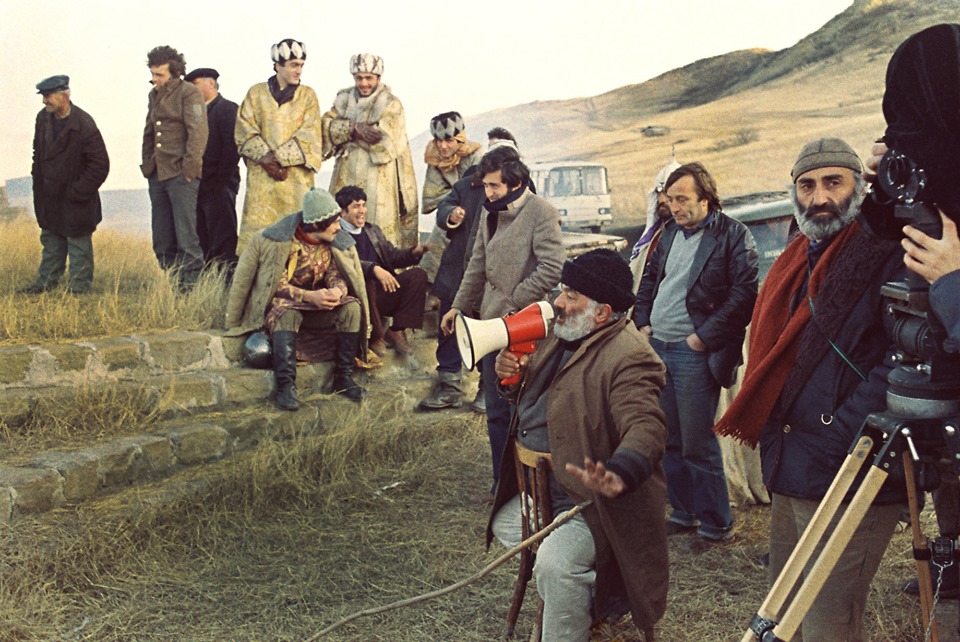
How we can describe a genius? What differs a genius from simply talented, gifted man? Geniuses are of course talented, gifted persons, but at the same time their main feature is an ability to achieve their goals despite all possible obstacles. More over sometimes those obstacles are a fertilize soil to grow their own flower. Parajanov spent four years in three ugly labor camps with killers and bandits. But he always admitted that being there was one of the greatest universities in his life. I can’t forget a dialogue between two greats – Parajanov and Tarkovski. I didn’t hear the whole talk. But in my presence Parajanov told Tarkovski that he regarded him as a very talented person but never a genius because, he stressed, that Tarkovski was not homosexual and never was imprisoned. You should only imagine Tarkovski’s big eyes, because he truly believed he was a genius. I will talk about Parajanov homosexuality impact on his art a little bit later. So he came out from prison stronger and wiser with a numerous art works which now decorate the walls of Parajanov museum. It’s so pity he was not allowed to work as a cinematographer another 4 years. But he not only waited for the bright days to come – he created every day, every hour and minute of his outgoing life. He found other ways to speak out – he created collages, ready-mades, assemblages. He organized joyful parties, met various people, gave advices to artists, told about his prison years in a way of small plays. He was the real Homo Ludens – he played with everything including people. It’s too pity that nobody recorded at least audio recordings of this fantastic talks. I still blame myself for that mistake. The only 16 mm 10 minutes silent film I shot in May 1980 depicting a journey organized by Parajanov to Aghpat and Sanain (monasteries where major part of Sayat- Nova was shot) was unfortunately lost. All I have are silent photographs which can’t render Parajanov non stopping theatre even a little.
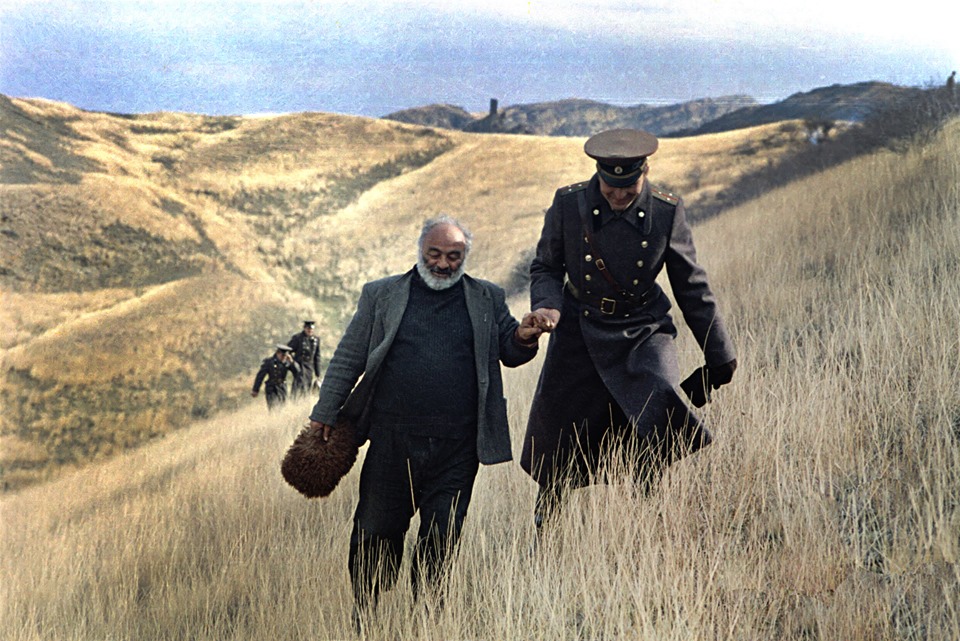
To explain for me and for the society Parajanov’s phenomena, I even invented a special verb – to parajanize, that means at the same time to exhibit himself, to mock, to provoke, to epatage, to challenge, to irritate, to offend, to attack, to burn all bridges, but first of all to create the world of his own, to confirm himself and everybody in actual necessity of his being. Of course this ability to parajanize offended some egg headed people at power. So they revenged at full scale in December 1973.

So main source of creativity for every artist, of course, is everyday life with its ups and downs. You should have something inside in order to burst it out. So Parajanov life was full of many events both tragic and comic and he obviously collected impressions for his big jump took place in 1964 with Shadows of Forgotten Ancestors. First of the tragic events that shocked Parajanov young soul was a death of neighbour girl Vera. As you know Parajanov started shooting his last film Confession with the scene of Vera’s funeral. There were only two days of shooting at all – Parajanov felt impossible to work more due to the mortal decease – lung cancer.
Second big blow was a more than tragic fate of his first wife Nigyar, who was killed by her own brothers. Then was painful divorce with Svetlana only year after the marriage. There was another attempt to create a family, now with actress Zoya Nedbai (she played in Kiev’s frescoes), but she was fiercely rejected by Sergei’s mother Siranush. She still wanted the reunion with Svetlana. Parajanov was three times arrested and imprisoned – in 1948, 1973 and 1982. So Parajanov lived his life to the extreme – the true precondition of being a real artist. The last heavy blow was a tragic death in November 1988, actually a suicide of his close relation, film studio set artist Alik Janshiev, who worked on all Parajanov Georgian films, played also the role of primitive painter Pirosmani in short length film Arabesque on Pirosmani theme. Besides Janshiev actually was co-author of almost all ready-mades and assemblages. It was really impossible for Parajanov bursting nature to glue one by one fragile elements of his wonderful glass creations. There were several reasons why Parajanov took great share of responsibility for such tragic outcome. I am sure that this tragedy provoked, awakened still latent lung cancer. Parajanov was so shocked that in masochist way he hanged of portrait of dead Alik in coffin on the wall. But Parajanov surprisingly managed to convert this comprehensive pain and grief into creative process. He turned to La Gioconda – Mona Liza image. I would like to add that he called my first photograph of him Gioconda too. It happened in November 1978, when we became familiar. So exactly ten years later he ordered his nephew Garry to buy all reproductions of Mona Liza in our biggest art shop. To Parajanov pleasure Garry managed to buy big size superb quality reproductions. On my opinion this series of works are real masterpieces performed with the greatest creative energy fueled with so contradictive emotions as love and grief. This work is a manifestation of his understanding of beauty, of his wisdom, of his fortitude. These works are not simply post modernism which flooded everything and which is using and trivializing the great Art of Past, but is truly the second Renaissance. First my impression when I saw these works was a kind of shock. The same shock I experienced when I first time saw Sayat-Nova. The real Art beside its main function –aesthetic and ethic message to the mankind – has one not less important function – creating a space of freedom, where author can create his own worlds, create his own universe. This way one can overcome own decease, fear, cowardice… This way one can dream, dare, achieve… Nevertheless the most important among Parajanov’s drives were comprehension and reconstructing of the beauty. – How beautiful it is, insanely beautiful! – was his favorite exclamation, coming from his unique ability to feel the material beauty created by human being. However his Giocondas are not simply beautiful, they are unlimitedly deep. Comparing with them Leonardo’s Gioconda is too simple. She is harmonically depicted on the peaceful country landscape background and she is looking at us from the depths of centuries with dignity, calmly, with light irony. Parajanov creates in the end of the bloodiest century in the history of mankind, which in addition to all its sins imposed on us a suicidal supremacy of consumption over the joy of creation. Parajanov’s Giocondas are product of our turbulent times – they are tragically playful, mockingly strict, at the same time they are passionate and unfeeling. Creativity of Parajanov has no boundaries, energetically this work is a work of a young man who lives his life vigorously and passionately.

Once I visited Sergei. He had guests from “Lenfilm”,colourists who were printing copies of the second great Parajanov masterpiece. All of us headed down Arsena Street and then turned on to Tkhinvali street. I guess Parajanov had been nurturing this idea for a long time. Well, here we are around the best view of Mount Mtatsminda, where we can produce a breathtaking shot,” the Maestro pronounced and indicated the spot, from which I would photograph the future masterpiece. Parajanov arranged the colourists at a distance, found a spot for himself and ordered me to take a photo. In those days, I used to photograph with a plain Soviet-made Zenith. Suddenly, Sergei jumped with such ease as I have never seen in him before, then again and again… The third take proved to be more or less successful. Parajanov christened it as “the still photo of the century”, and made a collage after it; as for myself, I named it “the black raven in flight”.
It happened when I met Parajanov I had no idea about his films. Now it’s so easy to know something! But for this time without VHS cassettes, not to speak of the Youtube, it was impossible to be familiar with Parajanov as a film director. When I first saw Shadows I was so impressed by cameraman Yuri Ilienko work, so I told Sergei that without eyes of Yuri he would never create such a beautiful and dynamic canvas. By this time I didn’t know that before The Shadows Parajanov shot on Dovzhenko film studio 4 full length feature films and three documentaries, which to put it politely, didn’t make him famous. Saying so, I seriously offended Parajanov. Then I understood that it was a long story. Such kind of talks took place shortly after this film was released. That’s why on my and not only on my opinion Parajanov started Kiev’s frescoes with camera literally nailed to the floor. He continued this method in Sayat-Nova. One of the reasons of such formal approach was to confirm Parajanov himself and others that secret of success was not necessarily linked with dynamic camera. Anyway I believe that Parajanov was lucky in both cases – he was able to collect perfect teams in order to realize his vision. By many reasons it never happened in Georgian films. The Legend of Surami Fortress and Ashik Kerib to a larger extent are not as perfect to me as previous Ukrainian and Armenian films. I have to admit that by this time Parajanov experienced the luck of energy. Sometimes he behaved as a primitive energy vampire, because after our relationship I often felt myself almost exhausted. So at the same time I am proud that I helped him even a little to replenish energy he needed so much. When he shot Shadows and Sayat-Nova he was on a peak, it was his acme period. Then he was out of work as a cinematographer for almost 15 years. Parajanov used to say that Fellini was so lucky, because he left this world performing all his projects, as for him he was going to leave with up to 20 unreleased scripts.
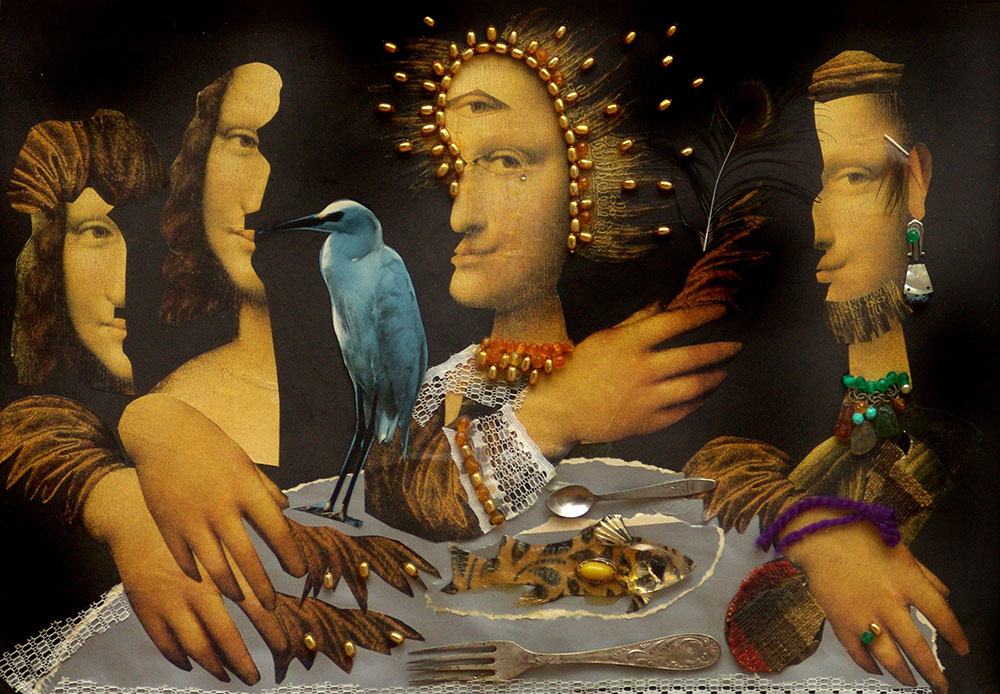
What about Parajanov homosexuality – in those old good times when it was not so widespread phenomena, now it’s a kind of fashion, more than that it was impossible to talk openly about such kind of deviation, because such person might be simply jailed, Parajanov managed to carry his peculiarity with a great dignity. I believe such surrounding, this feeling of being different, distinguished added something important to creative strength of Sergei. I can recollect once he said to me and my close friend Mark Polyakov. – Forget women and you will discover new horizons! Alas, we didn’t believe him. I am joking, of course. Because with his dual ability he was more than sensitive, he felt things the way which were not affordable for ordinary man.
And he always joked on that subject. Once I shot him with buckets full of trash. When I brought pictures of that event, Parajanov instantly created this collage where he placed naked women images in those buckets to highlight that he didn’t need women anymore. And contrary he organized this picture with prominent ladies of high circle and titled it “I came back to women!” One of his jokes was connected with Rotterdam film festival poster “20 film directors of the future”. As though somebody said to Parajanov, that he should be proud by being in top twenty. Sergei’s answer was that it was nothing because he was declared in top five homosexuals.
I have to add about Parajanov kindness. Of course, sometimes he was very cruel too, but only if somebody couldn’t accept a beauty the way he did. He worried about everybody – neighbors, friends, cinema team people. I witnessed one peculiar scene – an ordinary postman brought Parajanov a letter. Parajanov put on him a very expensive black leather jacket. Not long before I learnt that Sergei had no money to buy a cheapest matsun – a kind of Georgian yogurt. But this gesture with jacket was a gesture of a king. He was also very friendly with unfamiliar people like taxi drivers, shop sellers, children.
May be one of the rare feature of Parajanov was a unique ability to combine a hell and a heaven. That’s why he was so contradictive, sometimes being so kind, and sometimes being unbearable. I want to recall one story which was I heard from Serge Avedikyan. You know he is one of the film director and actor in feature film Parajanov. When Parajanov was in Paris in September 1988 he asked Serge Avedikyan to bring pencils, paints, color papers, miscellaneous things for collages. He managed to create one good composition and Avedikyan decided to buy it despite its high cost. So Serge took somewhere amount needed. They agreed to meet on cemetery at Tarkovski’s grave. It was fantastic scene, recalls Avedikyan: Parajanov was crying: Oh, my Andrey! You left me forever. I am alone now. And during this nonstop lamentation, Parajanov managed to ask Avedikyan several times, whether he brought him a money.
Another story happened with me personally. In 1985 I with my friends organized a photography exhibition. There were exhibited mainly portraits performed in neo realistic manner. And we were so proud of our works. Parajanov quickly looked through pictures, became extremely angry and shouted – Mechitov thinks that he is Parajanov at a time when Parajanov am I. What was that? Jealousy? Intolerance?

Last creative trick – Funeral of Parajanov, being himself a witness!
An amazing, frankly mystical story occurred in connection with this photograph. Only 20 years later did I notice, in the upper right corner of the photo, Sergei
Iosifovich himself, keeping an eye on his own funeral. I was so struck with this discovery that I began to successively enlarge the photo. My actions, despite their absurdity from a scientific point of view, repeated step by step the movements of the protagonist of Michelangelo Antonioni’s film Blow Up (1966). There is possibly a materialistic explanation of this fact – some old man who resembled Parajanov climbed up on the tree and was observing the funeral of the Maestro from there. But in this case I am not a materialist.

Yuri Mechitov, photographer

